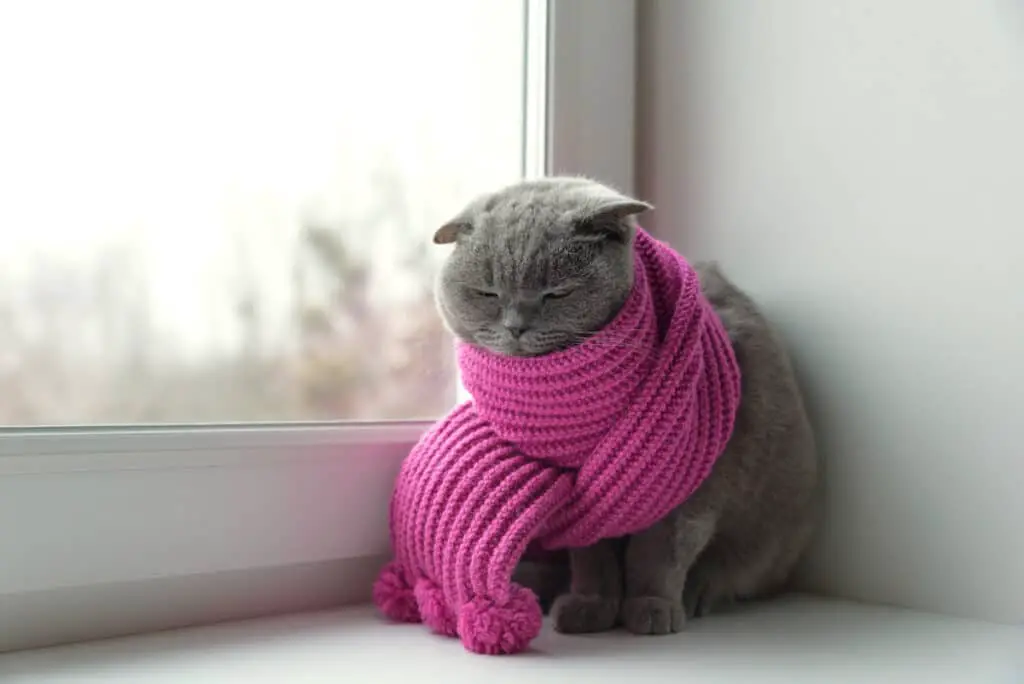Optimal temperature differs for each cat depending on breed, coat, age and health. However, a general temperature that is too cold for cats is about 45 degrees Fahrenheit. Another good rule of thumb is that if it’s too cold for you, it’s too cold for your cat.
When Is It Too Cold For Cats?
It’s easy to assume that because cats are independent creatures that have a coat of hair they can survive low temperatures. However, this is a complete myth and you may be surprised at the temperatures that are actually too cold for cats.
Among other factors, the temperatures a cat can withstand depend largely on her breed, coat, size, health and age. Some cats, like the Norwegian Forest Cat and Maine Coon have adapted to cold northern climates. In order to do this they’ve developed a thick coat of fur, sometimes with three specialized layers and have hair between their paw pads. Understandably, these cats can comfortably be in colder temps than the average cat.
Alternatively, some cats are not well suited for cold weather at all. Bengal Cats and other short hairs are more geared towards warmer climates. They have shorter coats that cannot keep them warm in colder temperatures.
A rule of thumb to follow is if it’s too cold for you, it’s too cold for the cat. For most cats 45 degrees Fahrenheit is too cold. And temperatures as low as 32 degrees Fahrenheit (freezing) can cause hypothermia and frostbite.

Signs it’s Too Cold For Your Cat
Cats, and animals in general, are notorious for hiding pain and discomfort. This is why it’s hard to tell exactly when the temperature is too cold for your cat. There are a few signs to keep an eye out for, though:
- Lethargy
- Dilated pupils
- Slow heartbeat
- Shivering
- Skin feels cold to the touch
- Slow or labored breathing
- Weakness
- Unwillingness to eat or drink
- Hiding
- Dark coloration of the ears or other extremities, indicating frostbite
Other Factors Affecting the Temperature That’s Too Cold for Cats
Although outdoor cat are not necessarily better suited for the cold, they’ve probably adapted behaviors to help cope with it. For example, they will have nesting areas they know to go to when it’s too cold. Studies show that indoor cats live longer than outdoor cats, so it’s a good idea to keep your cat indoors.
Both younger and older cats will have a harder time being in cold weather. Young cats do not have as much body fat to keep them warm, and their coats are often shorter. Older cats also may have less body fat and tend to generate less body heat in general.
Humidity, precipitation, wind, and the availability of adequate shelter also play a role in determining the temperature at which an outdoor cat is in danger. More humidity, high wind chill, and snow or ice will all cause more temperature-related issues for these cats.
How To Warm Up My Cat
The number on thing you can do to keep your cat warm is keep them inside. Obviously the weather outside varies far more drastically than inside, maintaining more optimal temperatures for your cat. If the cat is feral and must stay outside, provide them a bed and blankets to nestle up in. Also providing more food and calories is important; staying warm requires more energy.
Some short- or no-hair cats, such as Sphynx Cats, may need clothing to help keep them warm. Sweaters are both a practical way to stay warm and very cute.
Finally, providing a shelter filled with cozy blankets can help keep your cat warm. Make sure it’s in a location your cat feels comfortable going to.















